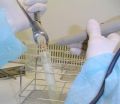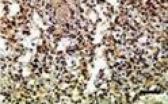(Press-News.org) Streptococcus mutans, one of the principal bacteria that cause dental caries, has increased the change in its genetic material over time, possibly coinciding with dietary change linked to the expansion of humanity. This is highlighted in a study by researchers from the Universitat Autònoma de Barcelona (UAB) and the Laboratorio Nacional de Genómica para la Biodiversidad (National Laboratory of Genomics for Biodiversity) in Mexico who, for the first time, have sequenced genetic material from this bacterium in populations from the past. Increase in genetic diversity has been produced especially in the fragment of a gene that codifies a virulence factor known as dextranase.
The research, published in Proceedings of The Royal Society B, has studied the bacterium in eleven individuals from the Bronze Age up to the twentieth century, in Europe and in both pre- and post-colonial America. The oldest case is that of an individual dating from 1200 BC, from the burial cave in Montanisell (Lleida, Catalonia); the most recent, from the UAB collection, dates from the beginning of the twentieth century.
"The relationship is well known between the increase in frequency of caries and the dietary changes that occurred in the Neolithic, or with the European discovery of America, with the large-scale introduction of sugarcane to Europe, or the Industrial Revolution, but what was not known was whether this change happened jointly with changes at a genetic level is this bacterium", explains Marc Simón, trainee researcher in the UAB Biodiversity doctorate and the article's principal author.
"We saw that, in the most recent populations, genetic diversity was greater; to us, this indicates a population-based expansion by the bacterium that may have occurred in parallel with the demographic expansion of humans. We think that this increase took place in the Neolithic. Currently, the oldest individual we have analysed is from the Bronze Age, but we might actually be witnessing the continuation of this process. In the future, we hope to be able to work with even older samples in order to corroborate our hypothesis".
The study opens up the possibility of providing evidence for the historical relationship between caries and human beings as well as ascertaining the ways in which distinct historical moments may have affected this; additionally, it makes it possible to reconstruct the dietary habits of the ancient population or of the population movements that took place.
For Assumpció Malgosa, researcher in Biological Anthropology at the UAB and coordinator of this research, "it is important to know how the gene varied in the past in order to predict models of evolution for caries virulence, to know whether these changes were a response brought about in order to adapt better to changing environments or even to other parts of the human body, such as the gastrointestinal tract, or if they changed to become resistant when conditions of hygiene improved, etc. Knowing how they reacted in the past in different situations can provide us with an idea of how they will do so in the future in similar circumstances".
INFORMATION:
The study was carried out in the UAB Physical Anthropology laboratory, with some of the samples being replicated in the Laboratorio Nacional para la Biodiversidad in Mexico. The project was financed by the Spanish Ministry of Education and Science, the Catalan Government (Generalitat de Catalunya) and the Mexican National Council for Science and Technology (CONACYT).
Ancient genetic material from caries bacterium obtained for the first time
2014-07-23
ELSE PRESS RELEASES FROM THIS DATE:
Linking television and the Internet
2014-07-23
The panel discussion is getting heated -- but what exactly is in the new proposed law that the experts on TV are arguing about so vigorously? Up until now, spontaneous questions such as these that arise during a program had to be clarified through a viewer's own research on the Internet.
If it's up to researchers at the Fraunhofer Institute for Intelligent Analysis and Information Systems IAIS in Sankt Augustin, Germany, viewers will no longer have to look up such additional information in the future. In the project "LinkedTV", the institute is working with eleven partners ...
Bats use the evening sky's polarization pattern for orientation
2014-07-23
This news release is available in German.
Animals can use varying sensory modalities for orientation, some of which might be very different from ours. Some bird species for example take the polarization pattern produced by sunlight in the atmosphere to calibrate their orientation systems. Now researchers from the Max Planck Institute for Ornithology in Seewiesen, Germany, and Queen's University Belfast have discovered with colleagues from Israel that a night active mammal, the greater mouse-eared bat, has the capability to orient using polarized light. These bats ...
Rising temperatures hinder Indian wheat production
2014-07-23
Geographers at the University of Southampton have found a link between increasing average temperatures in India and a reduction in wheat production.
Researchers Dr John Duncan, Dr Jadu Dash and Professor Pete Atkinson have shown that recent warmer temperatures in the country's major wheat belt are having a negative effect on crop yield. More specifically, they found a rise in nighttime temperatures is having the most impact.
Dr Jadu Dash comments: "Our findings highlight the vulnerability of India's wheat production system to temperature rise, which is predicted to ...
A crystal wedding in the nanocosmos
2014-07-23
Researchers at the Helmholtz-Zentrum Dresden-Rossendorf (HZDR), the Vienna University of Technology and the Maria Curie-Skłodowska University Lublin have succeeded in embedding nearly perfect semiconductor crystals into a silicon nanowire. With this new method of producing hybrid nanowires, very fast and multi-functional processing units can be accommodated on a single chip in the future. The research results will be published in the journal Nano Research.
Nano-optoelectronics are considered the cornerstone of future chip technology, but the research faces major ...
Intestinal parasites are 'old friends,' researchers argue
2014-07-23
Intestinal parasites such as tapeworms, hookworms and a protist called Blastocystis can be beneficial to human health, according to a new paper that argues we should rethink our views of organisms that live off the human body.
To prove the point, paper co-author Julius Lukeš even ingested three developmental stages of a large species of tapeworm called Diphyllobothrium latum. After more than a year with the tapeworms, which might have grown to be as long as four metres each by now, he says he feels fine.
"I knew there was no risk," he says.
Lukeš, a senior fellow ...
Toward an oral therapy for treating Alzheimer's disease: Using a cancer drug
2014-07-23
Currently, no cure exists for Alzheimer's disease, the devastating neurological disease affecting more than 5 million Americans. But scientists are now reporting new progress on a set of compounds, initially developed for cancer treatment, that shows promise as a potential oral therapy for Alzheimer's. Their study appears in ACS' Journal of Medicinal Chemistry.
Carlo Ballatore, Kurt R. Brunden and colleagues explain that in a healthy brain, the protein known as tau binds to and stabilizes microtubules, which are cellular components made of protein inside cells. Microtubules ...
Anti-pain agent shrinks oral cancers, leaves healthy tissues alone
2014-07-23
SAN ANTONIO (July 22, 2014) — Mouse models of human oral cancer treated with an agent called capsazepine showed dramatic tumor shrinkage without damage to surrounding tissues, researchers from the School of Dentistry and School of Medicine at The University of Texas Health Science Center at San Antonio found. The Health Science Center has claimed intellectual property on results of the study, which is described in the journal Oral Oncology.
Late diagnosis, low survival
Oral squamous cell carcinoma is the eighth most common cancer in the U.S. with 40,000 new cases and ...
HIV clinic-based audio project emphasizes the power of patient voices
2014-07-23
(MEMPHIS, Tenn. – July 22, 2014) The voice on the recording was low and calm as the speaker recounted the telephone call that brought the news he was infected with the human immunodeficiency virus (HIV) that causes AIDS: "My heart just stopped for a little bit and next thing you know I was on the floor flat on my face boohooing, crying like a baby."
Yet the message was hopeful when the recording ended less than 10 minutes later. "Don't feel like this is the end of you . . . because it is just God setting you up for something greater," the anonymous speaker tells an unseen ...
Chinese scientists search for evidence of dark matter particles with new underground PandaX detector
2014-07-23
The new PandaX facility, located deep underground in the southwestern Chinese province of Sichuan, hosts a large liquid-xenon detector designed to search for direct evidence of dark matter interactions with the nuclei of xenon and to observe 136Xe double-beta decay.
The detector's central vessel was designed to accommodate a staged target volume increase from an initial 120 kg (stage I) to 0.5 t (stage II) and ultimately to a multi-ton scale.
The technical design of the PandaX facility and detector is outlined in a new paper co-authored by Ji Xiangdong, of the Institute ...
High matrix metalloproteinase-9 expression induces microangiogenesis after cerebral infarction
2014-07-23
Basement membrane degradation and blood-brain barrier damage appear after cerebral infarction, severely impacting neuronal and brain functioning. Matrix metalloproteinase-9 is able to degrade the major components of the basement membrane around cerebral blood vessels and to mediate extracellular matrix remodeling. Therefore, Dr. Huilian Hou and colleagues from the First Affiliated Hospital of Medical School of Xi'an Jiaotong University, China induced cerebral infarction in stroke-prone spontaneously hypertensive rats by intragastric administration of high-sodium water (1.3% ...





